Computer vision system plays rock, paper, scissors
Researchers at the Ishikawa Oku Laboratory at Tokyo University (Tokyo, Japan) have developed a vision-based robot that can beat a human opponent at the game of rock-paper-scissors 100 per cent of the time.
Rock, paper, scissors is a game for two that is played using the players' hands. The two players each make a fist with one hand. The fist is then moved vertically three times. The third time, a player forms one of three items: a rock, a sheet of paper, or a pair of scissors. The winner of the game is decided by the item that is formed.
But the vision system developed in Japan that plays the game so well is really a cheat. To beat the human player each and every time, it uses a camera to capture the position and the shape of hand of its human opponent after the player has showed his hand.
A computer system then analyzes the image of the human hand and decides which of the winning three combinations it should play. The information is then used to actuate the fingers on the robotic hand to form the winning hand.
Because the speed of the system has a response time of one millisecond, however, it appears to the human opponent as if the computer-based system itself has responded at the same time as the human player.
The researchers have posted a video of the robotic hand in action on YouTube. It can be viewed here.
Increasingly, vision systems are teaming up with robotic systems to provide them with enhanced capabilities. Here's a compendium of ten of the top news stories on the subject that Vision Systems Design has published over the past year.
1. Robots team with 3-D scanners for fast part profiling
AV&R Vision & Robotics (Montreal, QC, Canada) has developed a system that combines visual inspection, robotics, and 3-D profiling techniques.
2. Robot 'dives' into nuclear reactors to provide real-time inspection
At the Massachusetts Institute of Technology (MIT; Cambridge, MA, USA), professor Harry Asada is working on a direct monitoring alternative: a small robot designed to dive into nuclear reactors and swim through underground pipes.
3. Vision-guided robotic 'bartender' serves drinks
Researchers led by professor Giovanna Sansoni at the Laboratory of Optoelectronics in the Department of Engineering at the University of Brescia (Brescia, Italy) have developed a vision-based robotic bartender that can serve customers different varieties of beer.
4. Robot vision helps guide UAV for crop spraying
Australian researchers are developing a flying robot as small as a dinner plate and a fleet of eco-friendly robotic farmhands that could help cut down the amount of herbicide sprayed on crops.
5. Vision-guided robot automates vegetation analysis
US researchers have developed a machine-vision-based system mounted on a skid steering robot that uses adaptive image segmentation and neural networks to identify vegetation varieties.
6. Vision-guided robots find a role in food production
Jarvis Products has developed a vision-guided robotic system to remove the internal organs of animals such as cows or pigs.
7. Vision guides service robots down into mines
Engineers at Sandia National Laboratories (Albuquerque, NM, USA) have developed a service robot that could rescue trapped workers from mines.
8. Intelligent robot performs bridge integrity analysis
US researchers have developed a robotic crack inspection and mapping (ROCIM) system that can conduct accurate assessments of cracking on bridge decks.
9. 3-D vision system helps cut poultry into pieces
Researchers at the Georgia Tech Research Institute (GTRI; Atlanta, Georgia, USA) have developed a prototype system that uses imaging technology and a robotic cutting arm to automatically debone chicken and other poultry products.
10. Cameras on a cat sail into action
An associate professor at the University of Arizona’s (Tucson, Arizona, USA) department of electrical and computer engineering has developed an autonomous robot that could be used for defense and security applications.
-- Dave Wilson, Senior Editor, Vision Systems Design
